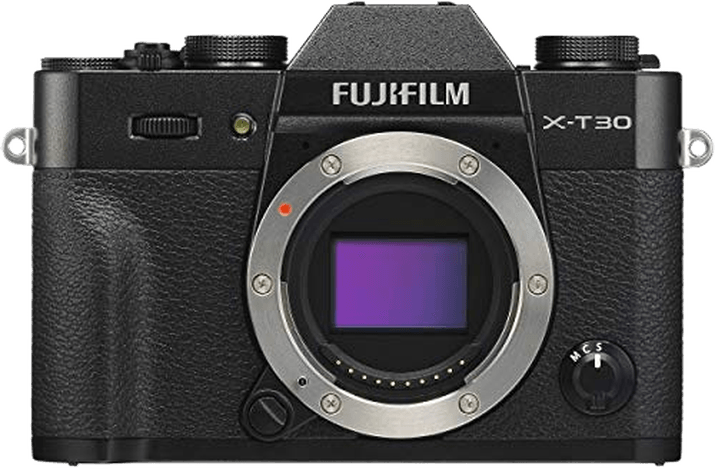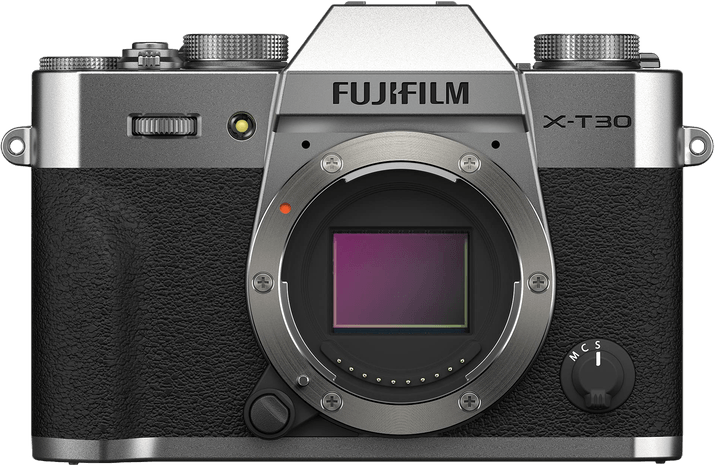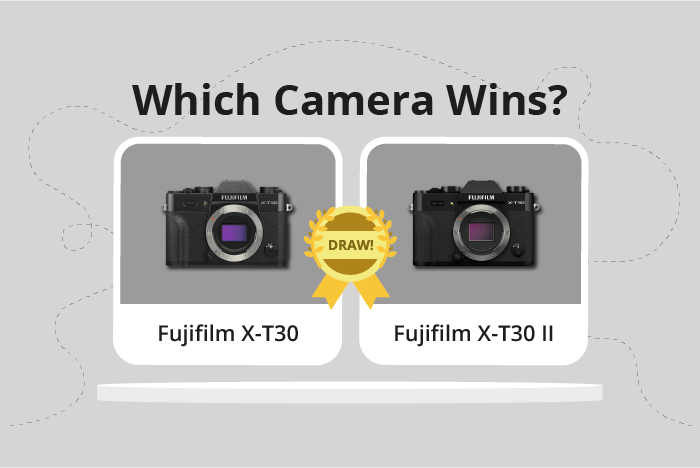Fujifilm X-T30 vs X-T30 II Comparison
Fujifilm X-T30

Fujifilm X-T30 II

The Fujifilm X-T30 and X-T30 II are both mirrorless cameras with identical scores of 65/100. They share the same announcement date, release year, launch price, camera size, and weight. Both cameras have a width of 118mm, a height of 83mm, and a depth of 47mm, with a weight of 383g or 0.84lbs.
The X-T30 II, being the newer model, offers some improvements over the X-T30, though they share many specifications. However, it’s important to note that the X-T30 still holds its own as a capable camera despite its age.
Taking all these factors into account, the Fujifilm X-T30 II may have a slight edge due to its more recent release, but both cameras are solid choices for photographers seeking quality and performance in a compact, mirrorless camera.
Fujifilm X-T30 vs X-T30 II Overview and Optics
The Fujifilm X-T30 and the Fujifilm X-T30 II both score 67/100 in optics, showing no difference in their optical performance. These cameras share several specifications, including 26 megapixels, 30 shooting speed, CMOS sensor type, X-Processor 4, APS-C sensor size, Fujifilm X lens mount, and no image stabilization.
Despite having the same score, the Fujifilm X-T30 offers certain advantages. Its optics have been tested and proven in the market, making it a reliable choice for photographers. Additionally, its lower price point compared to the X-T30 II could make it a more attractive option for those on a budget.
On the other hand, the Fujifilm X-T30 II, while having the same optics score, benefits from being a newer model. This means that it may have improved features, firmware updates, and better compatibility with new lenses and accessories. Furthermore, as a newer camera, it is likely to receive support and updates for a longer period than the X-T30.
In comparing the Fujifilm X-T30 and X-T30 II, it is evident that both cameras have identical optics scores and share many specifications. The X-T30 offers reliability and a lower price point, while the X-T30 II has the advantage of being a newer model with potentially improved features and longer support. Ultimately, the choice between these cameras comes down to individual preferences and needs.
Fujifilm X-T30 vs X-T30 II Video Performance
The Fujifilm X-T30 and X-T30 II both have a video score of 91/100, making them equal in terms of video capabilities. They share several video specifications, including a maximum video resolution of 4K, maximum video dimensions of 4096 x 2160, and a maximum video frame rate of 120fps. Additionally, both cameras have built-in time-lapse functionality.
Despite their equal video scores, the Fujifilm X-T30 has certain advantages. However, upon closer examination of the specifications provided, it becomes clear that the two cameras share identical video capabilities. As such, there are no specific areas where the X-T30 outperforms the X-T30 II in terms of video features.
Similarly, the Fujifilm X-T30 II does not have any unique video capabilities that make it better than the X-T30. Both cameras have the same video specifications, and neither one offers additional features or improvements in this regard.
Given that the Fujifilm X-T30 and X-T30 II have identical video capabilities, users can expect the same level of video performance from both cameras. The equal video score of 91/100 reflects this similarity, and potential buyers should not expect any significant differences in video features or quality between the two models. Ultimately, the choice between the Fujifilm X-T30 and X-T30 II may come down to factors other than video capabilities, as both cameras are evenly matched in this area.
Fujifilm X-T30 vs X-T30 II Features and Benefits
The Fujifilm X-T30 and the Fujifilm X-T30 II both earned a feature score of 70/100, making them equal in this aspect. They share several specifications, including a 3-inch screen size, 1040000-dot screen resolution, touchscreen capability, flip screen, and the absence of GPS. Additionally, both cameras have WIFI and Bluetooth connectivity.
However, there are no differences between the two cameras in terms of features, as they share the same specifications listed above. This means neither camera is better than the other in this regard. Since both cameras have the same feature score and identical specifications, it is not possible to determine a winner or loser in this comparison.
Therefore, when considering the features of the Fujifilm X-T30 and the Fujifilm X-T30 II, one cannot say that one camera is better than the other. Both cameras offer the same set of features, providing users with similar experiences and capabilities. The choice between these two cameras will ultimately depend on factors beyond their features, such as price, availability, or individual preferences.
In this comparison of the Fujifilm X-T30 and the Fujifilm X-T30 II, neither camera emerges as a clear winner or loser based on their features. Both cameras offer the same specifications and capabilities, ensuring that users will have a similar experience regardless of which camera they choose.
Fujifilm X-T30 vs X-T30 II Storage and Battery
The Fujifilm X-T30 and X-T30 II tie in storage and battery with scores of 35/100 each. Both cameras have one memory card slot accepting SD, SDHC, and SDXC cards (UHS-I compatible). They share the same battery type, NP-W126S, and offer USB charging.
Both cameras provide equal battery life, lasting for 380 shots. Neither camera outperforms the other in this aspect, as they share identical battery and charging specifications.
Despite their similarities, neither camera has an advantage over the other in terms of storage and battery. The Fujifilm X-T30 and X-T30 II maintain equal performance, making this aspect a draw between the two models.
Fujifilm X-T30 vs X-T30 II – Our Verdict
Are you still undecided about which camera is right for you? Have a look at these popular comparisons that feature the Fujifilm X-T30 or the Fujifilm X-T30 II:

